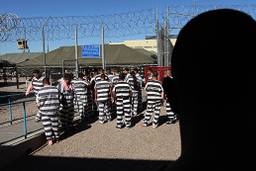
The sleepy town of Hardin, Mont., began its foray into the private prison industry in 2004, an adventure that would eventually saddle it with millions in debt and an empty, 464-bed prison collecting dust at the edge of town.
It all started when James Parkey, the founder, owner and president of Texas-based Corplan Corrections, met with then-Montana Gov. Judy Martz ® at Las Vegas McCarran International Airport while Martz was en route to the Western Governors Association meeting in Santa Fe, N.M.
Since the 1980s, Parkey’s company has developed 33 private jails or detention centers in New Mexico, Texas, Idaho, Louisiana and Colorado. Corplan’s fortunes, along with those of private-prison giants Corrections Corporation of America (CCA) and Geo Group (formerly Wackenhut), date back to the “tough-on-crime” legislation of the ’80s and ’90s, when mandatory minimum sentencing guidelines pushed the U.S. prison population up to about 2.5 million – an 800 percent increase over the number of people incarcerated in 1970, the year before the commencement of Nixon’s War on Drugs.
But with the prison population leveling out and more states facing budgetary crises, lawmakers have questioned the wisdom of stiff sentencing guidelines. Consequently, the private-prison industry has moved onto the greener pastures of immigration detention centers.
Unfortunately for Parkey and members of his private prison consortium – a group of construction companies, bond underwriters, consultants and small private prison operators – the biggest federal contracts to build immigration facilities are snapped up by big-dog corporations such as CCA and the Geo Group.
Small operators gnaw primarily on the scraps provided by state, county and municipal adult and juvenile inmate populations.
Enter the rainmakers
Parkey’s scheme goes like this: he and/or one of his pitchmen approach an economically-depressed and isolated community – preferably within 100 miles of a federal courthouse – and convince local government leaders during a period of wining and dining – and sometimes bribing – that a private prison, jail or immigrant detention center is just the thing to cause long-dormant clouds of cash to burst open and rain prosperity down on their blighted town.
Bond underwriter Municipal Capital Market Group (MCM), a core component of the Parkey-led consortium, commissions a feasibility study, which invariably indicates that the time and placement of such a facility is indeed ideal. Soon, a “private facility corporation” (PFC) is created by the county to issue bonds.
After MCM and another bond underwriter produce a document detailing the prison’s construction and operation, and a municipality signs off on it, the project begins. Though the actual underwriters, designer and analyst used remain unchanged through the vast majority of Corplan developments, the scheme has three recurring pairs of operators and builders – Community Education Centers, Inc. (CEC) and Hale-Mills Construction; Emerald Companies Corporation and McInnis Brothers Construction (both based in Louisiana); and Management and Training Corporation (MTC) and HMC Contracting South Texas, LLC (an incarnation of Hale-Mills).
The facility is then built, and the community is left to deal with the consequences. Meanwhile, all contractors involved in the development have been paid in advance out of bond sales.
Following the 2004 Las Vegas meeting, Parkey and representatives from Hale-Mills, MCM and CEC were invited to Billings, where they met then-director for Hardin’s Economic Development Paul Green, who invited the consortium to look into the possibility of construction east of Billings. In 2006, after two feasibility studies commissioned by MCM and conducted by Howard Geisler of GSA, Ltd., presented a need for up to 400 prison beds in the region, Hardin’s PFC issued $27 million in bonds. The bonds were to be paid off with revenues – on top of the supposed $100,000 annually the town was set to make in revenue – generated through per diem payments received from other jurisdictions for housing their overflow inmates in the new prison.
The prospectus used to sell the bonds detailed a guaranteed fee of $19.8 million to be paid to the designer and builders of the jail, Hale-Mills. While neither Parkey’s name nor Corplan appear anywhere in the bond statement, Parkey is an architect by trade and bills himself as a designer of prisons. Parkey declined to comment on his compensation in the deal, but it is safe to infer he drew his pay out of this nearly $20 million cut.
The facility was completed in 2007, but Hardin was unable to find any prisoners in Montana to house in the jail. It began looking out of state, offering its services to the Wyoming Department of Corrections. An inspection, however, found the new facility unfit to contain long-term felony offenders – and indeed it was, having been designed and built as a dormitory-style jail intended to house low-risk inmates awaiting trial or sentencing.
Had Hardin officials looked into the consortium’s past, they would have discovered that, at about the time Parkey was arriving on their doorstep in 2004, a jail that Corplan and MCM developed in Pioche, Nev., in 1993 had been sitting vacant for more than a decade. That same year, it was purchased by Lincoln County, Nev., for $500,000 – pennies on the dollar for the $3.5 million issued in long-since defaulted municipal bonds.
As Hardin’s economic development director, Green says alarms began going off. “I was getting calls from people as far away as Alaska – people telling me that private jails and these people are nefarious.” So in 2004, intent on checking out the group’s claims for himself, Green traveled to several rural communities in southwest Texas that host Corplan-developed detention facilities.
A mess in Texas
Hudspeth County is very similar to Hardin in some ways: population about 3,500, 70 miles from a decent-sized city (El Paso), a high rate of unemployment and a largely uneducated work force.
Hudspeth County was, at that time, constructing the West Texas Detention Facility (WTDF). Hudspeth County Judge Becky Dean-Walker, head of the county commissioner’s court, denies that bonds were ever issued by the county to construct the WTDF. But in 2003, a group of citizens gained a restraining order against the WTDF Corporation (the PFC headed by Sheriff Arvin West and two county commissioners), the Hudspeth County Commissioner’s Court, and bond underwriters Herbert Sims & Co. (another bond underwriter commonly associated with the consortium) and MCM, on the grounds that they had violated Texas Open Meetings Law in approving the bonds without public knowledge.
A Texas district court judge later voided the order and the bonds were issued. “There was some stuff that went through and the county signed some papers on it, but the county did not issue the bonds,” says Dean-Walker, who is listed as the detention facility’s contact on the Corplan website.
She insists that the jail was solely financed by some group of private investors whose names she does not remember. She says the facility is not owned by the county, Emerald (the facility’s operator) or Corplan. It is, she says, the sole responsibility of the “private investors.”
However, according to the bond statement on file with the Texas Bond Review Board, in 2003 the West Texas Detention Facility Corporation issued about $23.5 million in bonds as a public instrumentality of Hudspeth County for the construction of the facility. Much like in Hardin, the county was supposed to help pay off the debt using per diem prisoner revenues.
According to the Texas Bond Review Board, the county already owes some $17 million in interest on the bonds issued for the facility, which opened in 2004 and which initially had a difficult time finding inmates.
On March 25, 2005, Corplan consultant David Cortez went before a federal judge and pled guilty to charges of giving $10,000 each in bribes to two Willacy County, Texas, commissioners in another prison-building project. The commissioners both pled guilty to accepting the bribes two months earlier.
Parkey denies any involvement or knowledge of wrongdoing in Willacy. “I think they just worked a deal among themselves and split some fees,” he says. “We had nothing to do with it.”
In Hudspeth County, Walker says, “I can’t sit here and tell you that nobody ever took a bribe from them or anything, but as far as I know, they didn’t … at least not to the point of getting caught.”
As for his frustrated former clients in Hardin – who cannot even afford to hire staff for their still-empty $27 million facility – Parkey says: “I have no opinion on it – it’s a local issue.”









